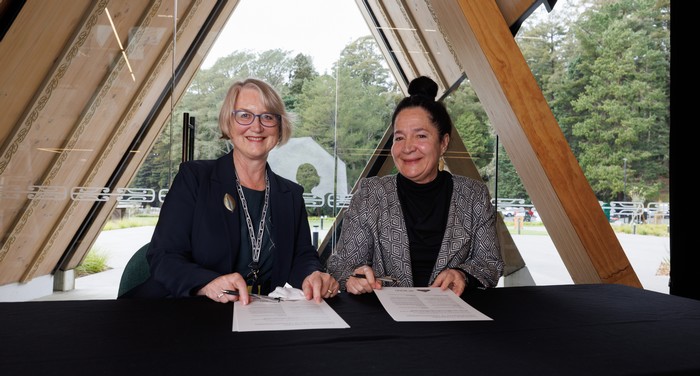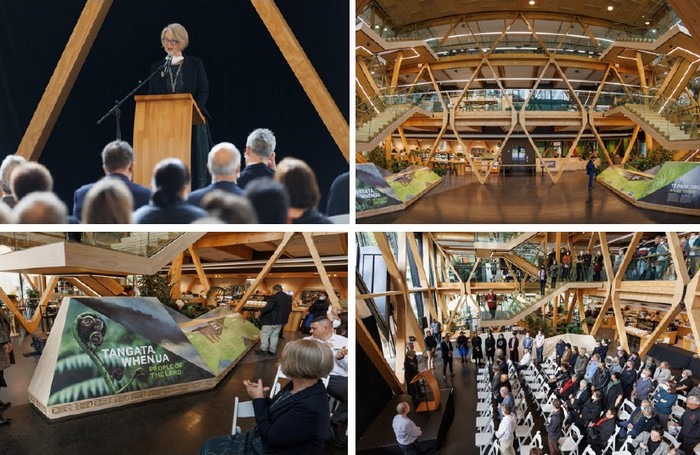Kawenata honours spirit of partnership

The growing partnership between tangata whenua and Scion was formalised by the signing of a Kawenata / Memorandum of Understanding in a special ceremony last year.
Its signing in August 2022 between Ngāti Hurungaterangi, Ngāti Taeotu and Ngāti Te Kahu (Ngā Hapū e Toru) and Scion was a significant event for all parties who were pleased to see a journey that started decades earlier come to fruition.
It was appropriate that the signing of the Kawenata in both te reo Māori and English occurred at Te Whare Nui o Tuteata – the Great House of Tuteata. In October 2020, Ngā Hapū e Toru had gifted the name of their ancestor, Tuteata, to Scion for its headquarters in Rotorua to signify the importance of the partnership that they were building together.
The Kawenata and gifting of the name Tuteata are two of the many positive outcomes to emerge from conversations that started many years ago involving Ngā Hapū e Toru, including the late Ben Hona and George Mutu. Kōrero focused on a collective vision to restore their physical connection to the whenua around Whakarewarewa Forest.
Ngā Hapū e Toru trustee Veronica Butterworth explains that when the land was used by the Crown as a forest nursery from 1898 and then for forestry research from 1947 onwards, physical connection of the hapū to this land was severed. The spiritual connection, however, remained.
Historically, it had been a site where whānau lived and cultivated the land for kai, such as kūmara and aruhe (fern root). Birds, fish and other food sources were abundant.
“Land is the basis of identity and wellbeing for our people,” Butterworth says.
“We are genealogically connected through our whakapapa to the land itself, which ties us to various parts of the natural environment. These are fundamental aspects of our culture and our lives. Whakapapa and whanaungatanga give rise to obligations to look after the land, the waters and the environment on behalf of our ancestors and ourselves for future generations.”
Butterworth adds the signing for Ngā Hapū e Toru was a significant step forward in the partnership with Scion, which in turn was a step towards strengthening the mana of the land and hapū.
“This land is part of our rohe, our tūrangawaewae, and is the basis of identity and wellbeing for our people.”
Moving forward
Working together, the hapū and Scion will honour five matapono (principles) of the Kawenata: whakapapa, kotahitanga, rangatiratanga, manaakitanga and tiakina te mana o te whenua.
Scion chair Dr Helen Anderson says the signing marked a significant milestone for the Crown Research Institute and its enduring relationship with tangata whenua.
“We have signalled how Scion and tangata whenua recognise the value of working together in the spirit of cooperation and partnership. We have common principles and an unwavering commitment to protect the waterways, forests and whenua.
“As Scion takes bold new steps with research to support New Zealand’s transition to a circular bioeconomy to help meet our climate change objectives, we have committed to a set of principles that will underpin our close relationship with tangata whenua and help us navigate the challenges and opportunities ahead.”
For Tamara Mutu (Ngāti Hurungaterangi, Ngāti Te Kahu) Hunga Whakahaere Matua – Operations Manager, the Kawenata represents a major step forward in efforts to align the kawa (protocol) and tikanga (customs) of the hapū within Scion and normalise hapū values.
Her role at Scion was created in 2021 to build relationships with Ngā Hapū e Toru. The role was established by Scion, Te Uru Rākau, New Zealand Forest Service, and Timberlands – key tenants on the 114ha site, known as Te Papa Tipu campus, where Ngā Hapū e Toru are tangata whenua.
In her role, Mutu is focused on strengthening partnerships between the three hapū, Scion and other tenants, looking for mutually beneficial opportunities.
Strengthening connections
The Kawenata signing was followed by the launch of a new permanent visitor display in the building’s atrium.
This shares the Kawenata and connection that Ngā Hapū e Toru have to the whenua, while also explaining the significance of forestry science and innovation to New Zealand and the world.
Co-funded by Scion and Te Uru Rākau, New Zealand Forest Service, the displays are a creative bilingual storytelling experience that explore the history of tangata whenua, forestry and the future.
One display describes Ngāti Hurungaterangi, Ngāti Taeotu and Ngāti Te Kahu. It explains the deep connection to the whenua, with historical pā, kāinga (settlements), cultivations and wāhi tapu (sacred sites), as well as looking to hapū aspirations – including partnership and tino rangatiratanga.
The other display documents the history of New Zealand’s forestry industry, starting in the late 19th century when the first exotic trees were planted in a nursery at the Whakarewarewa Forest. The storytelling explains the value of radiata pine, along with the importance of forests to New Zealand for timber production, biodiversity, biomaterials, tourism and to tackle climate change problems the world faces.

The Kawenata and its principles can be viewed online:
